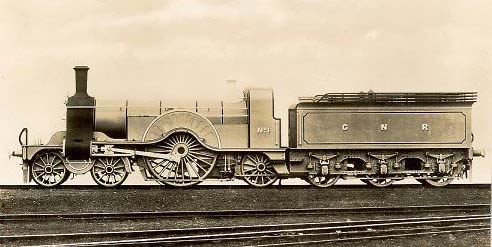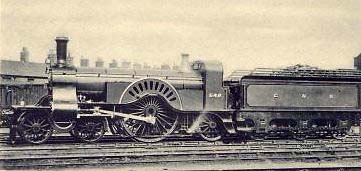|
This
locomotive was designed by Patrick Stirling, the chief designer
of England's Great Northern Railway. Its elegant lines, gleaming
paintwork, and polished brass trim combined to make it one
of the most beautiful engines ever. The most noticeable characteristic
of these locomotives was the huge 8-ft driving wheels, which
allowed the engines to reach very high speeds. Patrick
Stirling died in 1895.
Until
1882, when passengers boarded a train, they had to stay in
the same compartment until the train stopped - there was no
way to move from one compartment to another. In that year,
cars with a side aisle came into service. At each end of the
aisle was a restroom - one for ladies, the other strictly
for gentlemen.
When
the Stirling's driver pulled the brake lever, a vacuum was
created in the brake pipe. This pushed the brake shoes onto
the wheels and brought the train to a halt.
Patrick
Stirling - Designer
Patrick
Stirling was better known for the latter part of his career
(1866-1895) on the Great Northern Railway in England.
He became locomotive superintendent at Glasgow & South
Western Railway in 1853 at the age of 33, and arranged for
his works and departmental headquarters to be moved from cramped
premises in Glasgow to a new site at Kilmarnock.

Patrick
and his younger brother James virtually standardised the very
successful all-purpose mixed traffic 0-4-2 tender locomotive,
gradually enlarged with each succeeding class, with a few
0-6-0s for heavily graded lines and mineral work. Main line
passenger trains were hauled by 2-2-2 ‘singles’ soon uprating
in power to 2-4-0 and 4-4-0 types under brother James after
Patrick had moved on to Doncaster on the Great Northern Railway.
History
of the Stirling Single.
Fifty-Three
engines of this type were built between 1870 and 1895 at the
Doncaster works of the Old Great Northern Railway to the design
of Patrick Stirling. For a long time they worked a large part
of the East Coast route and in this capacity achieved notable
speed performances. Engines of this class figured in the Railway
Race to Edinburgh in 1888 and the Race to Aberdeen in 1895.
The
engines were distinguished mainly by their one big pair of
single driving wheels, the diameter of which was 8 ft. 1 in.
Outside cylinders (18 in. diameter by 28 in. stroke) were
provided; the total heating surface of the boiler was 1,165
sq. ft. ; the working pressure 140 lb. per sq. in., and the
weight of the engine, in running trim 38.5 tons.
The
weight of later engines of this type was increased to 45 tons,
and the working pressure to 160 lb. Among other distinctive
external features of these engines was that the boiler carried
no dome but, as was customary in all Stirling designs, was
bare of mountings from the chimney right back to the safety-valves.
No.1, the first of the Stirling "8-footers," can be seen in
the Railway Museum at York.
These
locomotives had a distinctive outward appearance, with their
domeless boilers, outside cylinders and the sweep of the footplate
over their 8 0' dia. driving wheels and the mechanical design
enabled them to maintain a very high standard of reliability
in all conditions of working. The original No. I locomotive
of 1870 was not withdrawn from service until as late as August
1907 in which time it completed upwards of 1,400,000 miles.
It is a remarkable life for an old locomotive which cost only
£2,076 to build.
Although
withdrawn from service in 1907, the No. I locomotive was again
in steam in 1925, when it took part in the procession of locomotives
between Stockton and Darlington on the occasion of the Railway
Centenary celebrations. This locomotive was again brought
into service In 1938, when It was given a general overhaul
and provided with a train of old East Coast 6-wheel carriages,
with which it made a number of excursions to mark the 50th
Anniversary of the Railway Race to the North.
|